How to Fix Mashed Potatoes
Mashed potato problems and pitfalls, and how to avoid or fix them.
When flannel and pumpkins start popping up all over the place and the holidays are around the corner, it's officially mashed potato season. Mashed potatoes are classic comfort food, and the kind of simple side dish that everyone should know how to make. But that's not to say perfecting them is easy, and there are plenty of fine details that can spell the difference between mashed potato success and failure. If you do have concerns when making mashed potatoes, we hope that this little guide will help answer questions and help you out in your time of need.
How to Avoid Making Soupy, Runny, Bland Mashed Potatoes
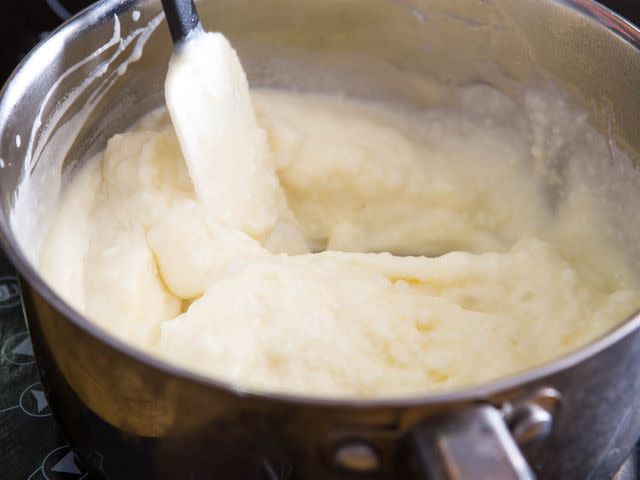
Serious Eats / Vicky Wasik
If you haven't ever made or been served a runny, watery batch of mashed potatoes, consider yourself lucky. They're not pretty or delicious, but they are extremely disappointing. Mashed potatoes need to have some structural integrity in order to properly construct the levee walls for a gravy reservoir on your holiday dinner plate.
The easiest way to ensure that you don't run into a soupy spud problem is to use proper technique during the mashed potato cooking process, and avoid some common pitfalls.
First and foremost, don't cut your potatoes too small or cook them too long. Cutting potatoes into a small dice for a batch of mashed potatoes may speed up their cooking time, but it also increases the surface area through which the potatoes surrender flavor compounds, starch, and pectin to the cooking water. This increased surface area also means that more water is absorbed by the potatoes, causing them to become water-logged. More absorbed water means that the potatoes can't absorb as much flavorful dairy later on in the process. So make sure to cut potatoes into large enough pieces—one to two inches—and cook them until they're just tender.
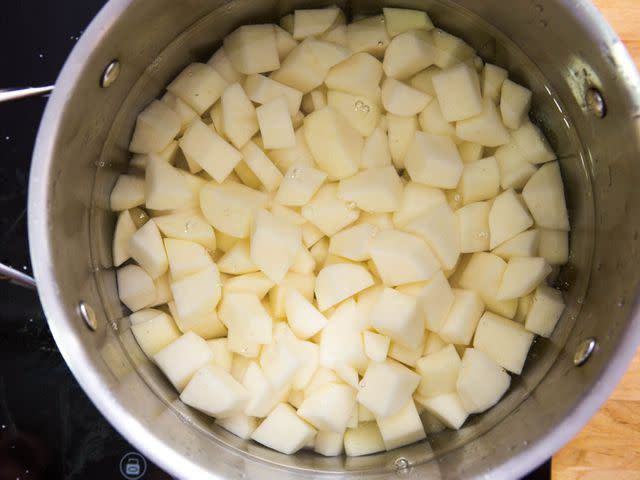
Serious Eats / Vicky Wasik
Once the potatoes are cooked and riced, you want them to be as dry as possible before incorporating the butter and milk (or cream) into them. As with recipes for potato gnocchi that call for letting the potatoes dry out slightly after processing, we don't want the potatoes to be wet before adding more wet ingredients to them. The goal is to have the potatoes absorb the flavorful milk and butter, and that's not going to happen readily if they're already water-logged. You can dry out potatoes by putting them in a pot over low heat on the stovetop, or even on a baking sheet in a low oven, before stirring in the butter and milk.
Once you get to the point of adding the dairy, don't add everything in with the potatoes all at once. Start by incorporating the butter into the potatoes (this is best done with melted butter, which will coat them evenly without having to be stirred vigorously); the fat coats the starch in the potatoes, preventing it from interacting with the water in the milk once that is added. This keeps the potatoes fluffy and creamy, rather than turning them gluey and heavy.
When adding milk, work it in a little at a time, adjusting the amount as needed to produce your desired mashed potato texture. There's no simple way to remove liquid once you've added it to the potatoes, so it's always a better idea to add in a bit at a time then to just dump in a the full amount that a recipe calls for.
How to Fix Soupy, Runny, Bland Mashed Potatoes
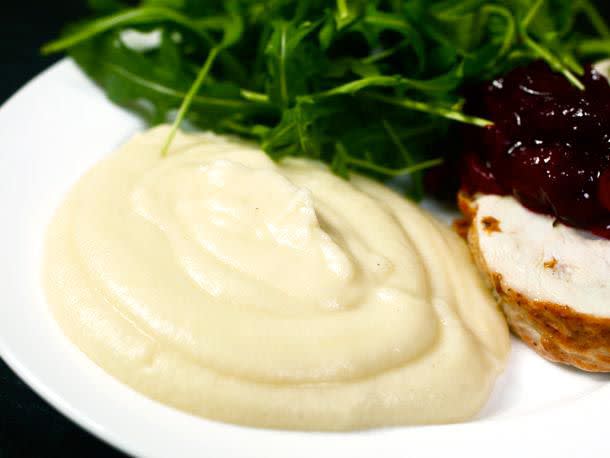
Serious Eats / J. Kenji López-Alt
If you do end up with a mess of mashed potato soup on your hands, don't despair. There are some ways to rescue your spuds by thickening them back up. If the potatoes are soupy but still taste good, the goal here is to thicken the potatoes without sacrificing or compromising their flavor. If they're runny and taste watery, then you'll need to fix both of those issues.
If you have extra potatoes and time on your hands, you can simply cook a couple more, rice them, and fold them into the loose batch you already have. This will thicken them up and also reinforce their flavor.
When you're short on time, a box of instant mashed potatoes is a life-saver. Adding a handful of these flakes of cooked, mashed, and dehydrated potato is an easy way to tighten up a runny batch of mashed potatoes.
You can also tighten up your mashers with starch (the very thing we were trying to avoid in the first place with fluffy potatoes). Cornstarch, tapioca starch, and potato starch will all work, but they have different gelatinization temperatures (tapioca starch has the lowest at around 140°F/60°C). Heat your soupy potatoes and whisk in a tiny bit of starch at a time until you achieve the right consistency. Regular flour can also be used to thicken your potatoes as well, but I don't love using it because its raw flavor needs to be cooked out, and it more noticeably dulls the flavor of the potatoes themselves.
How to Avoid Making Gluey Mashed Potatoes
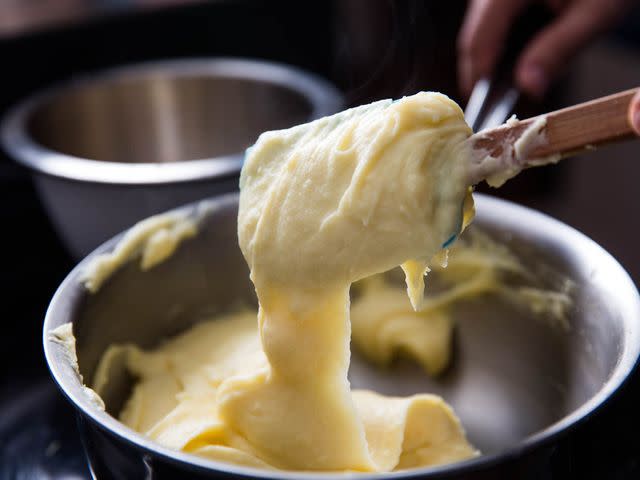
Serious Eats / Vicky Wasik
On the other end of the problematic mashed potato spectrum, we have the dreaded stiff and gluey mashed potatoes. As already discussed, pastiness is caused by too much potato starch being worked into the mashed potatoes.
The main way we combat this problem is by rinsing away starch, both before and after cooking potatoes for fluffy mashed potatoes. Rinsing off starch means that there is less of it that can end up in the dish.
When breaking down the potatoes, it's important to take care not to "overwork" them. Violently breaking them down causes more starch to be released, which leads to stickier, pastier potatoes. This is why processing potatoes in a blender or food processor is never a good idea, and will result in an elastic, mozzarella-like texture. This is actually a popular way to make vegan nacho cheese sauce—definitely not the texture you want for mashed potatoes.
Using a potato ricer or food mill breaks down cooked potatoes without overworking them, and from there you can gently fold in butter and milk for light and airy mashed potatoes, or you can control the level of starch manipulation to produce creamy pommes purée.
How to Fix Gluey Mashed Potatoes
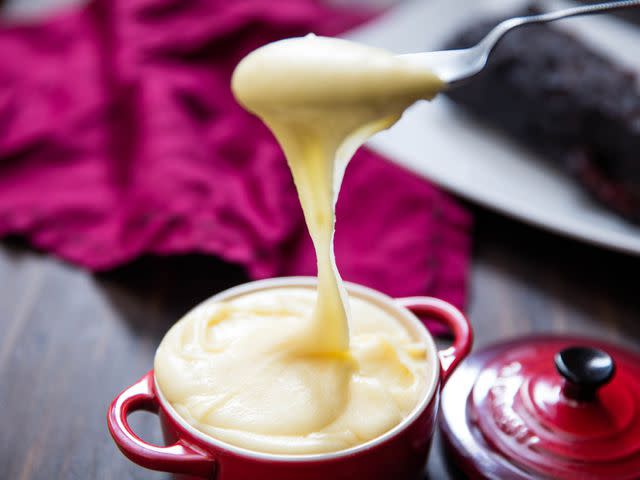
Serious Eats / Vicky Wasik
The bad news with gluey mashed potatoes is that there's no real way to fix them. Once you've incorporated that excess starch into the mix, you can't take it out. One of the chefs that I worked with had a favorite saying for moments like this: "You gotta dance with the girl you took to prom."
You can either start over and make a fresh batch of mashed potatoes, or make the best of the situation: Embrace the gluey potatoes, and turn them into stretchy, cheesy pommes aligot, which Daniel calls the lovechild of mashed potatoes and fondue. When life gives you pasty potatoes, this is a pretty delicious dish to make with them.
Can You Make Mashed Potatoes Ahead Of Time?
Once you've figured out how to make mashed potatoes without messing them up, you may be curious if they can hold up over time, or be made in advance. The answer is yes. Daniel has outlined a number of ways that you can make whipped potatoes ahead of time, and heat them up when it's time to eat.
Whether you turn them into a mashed potato casserole, hold off on the milk until re-heating them restaurant-style, or keep them warm in a sous vide water bath, serving hot potatoes shouldn't stress you out.
If All Else Fails...Go the Supermarket Route
If something goes terribly wrong and you can't make, fix, or reheat a batch of homemade mashed potatoes, there' always the supermarket option. Most supermarkets sell pretty decent mashed potatoes in their prepared food section, and can easily doctored up to taste surprisingly good. I had never purchased potatoes like this until my wife turned me onto them as a quick weeknight dinner cheat code. She is a master of improving them with a little milk, butter, Dijon mustard, salt, and a ton of freshly ground pepper—you'd never know that they weren't homemade. I'm not saying you shouldn't make mashed potatoes, but it's nice to know that when all else fails, you still have options.
October 2019
Read the original article on Serious Eats.

